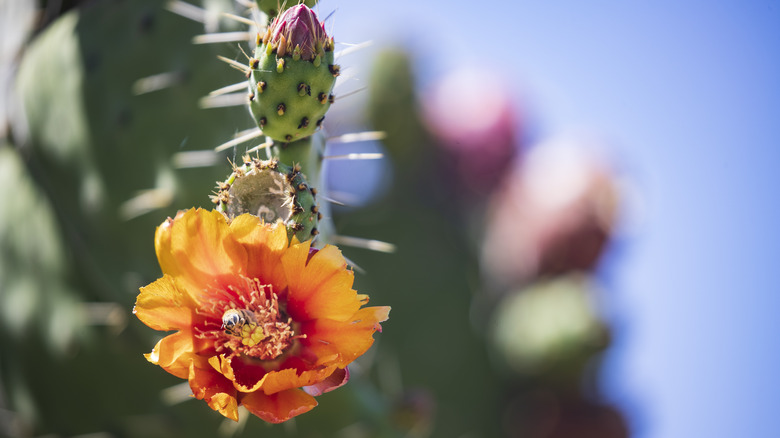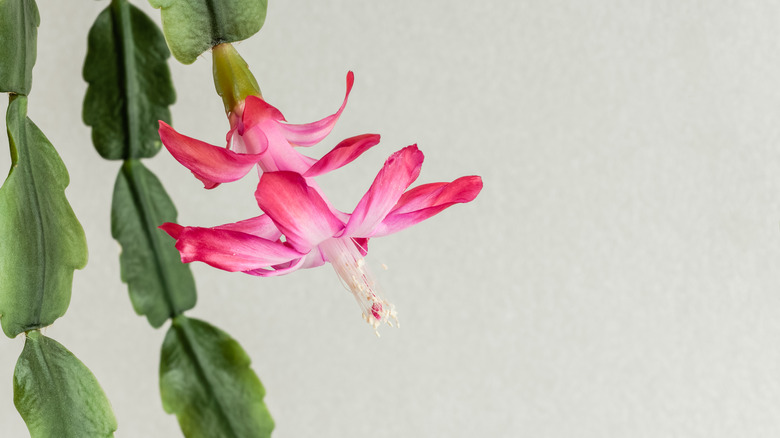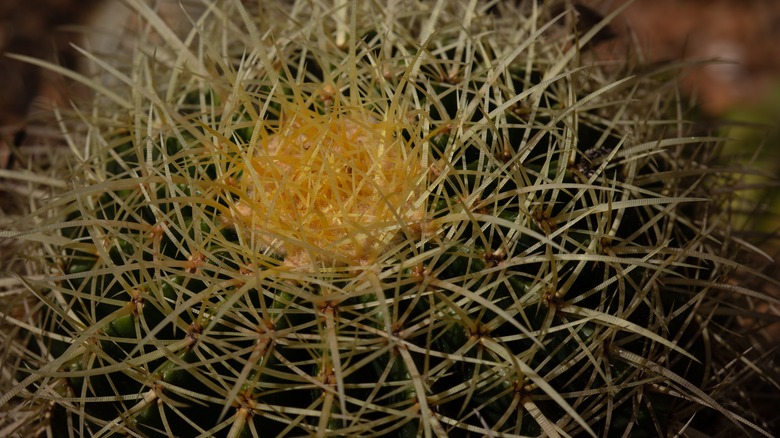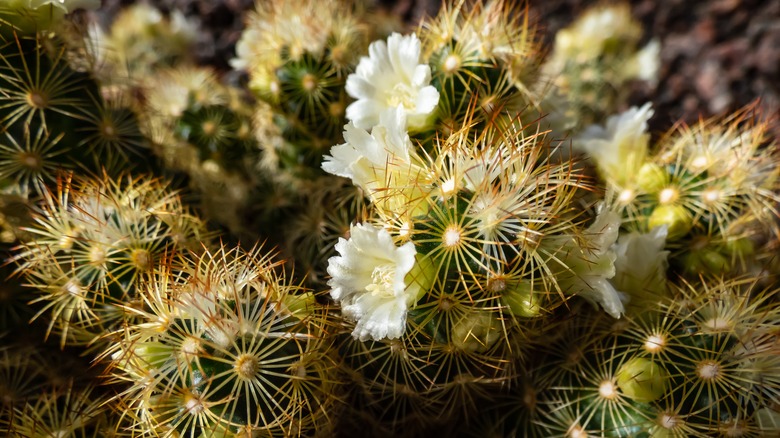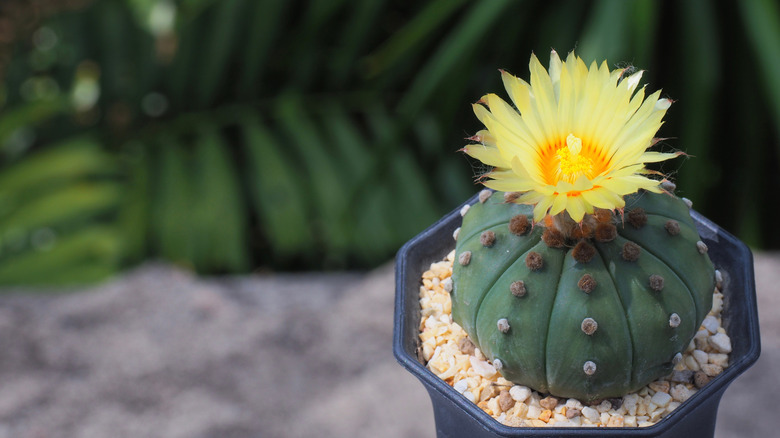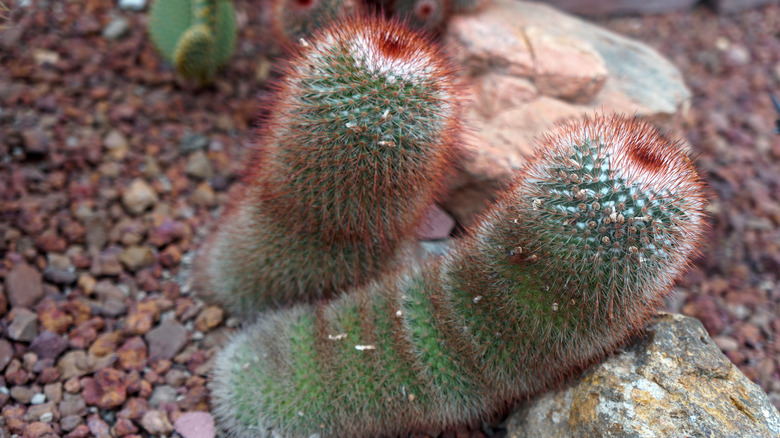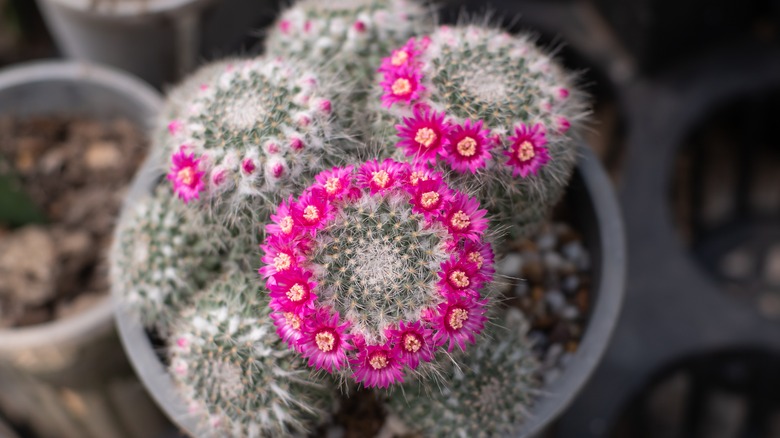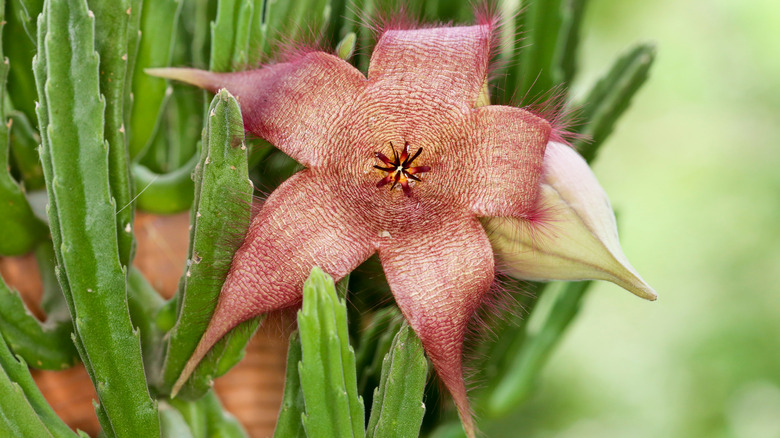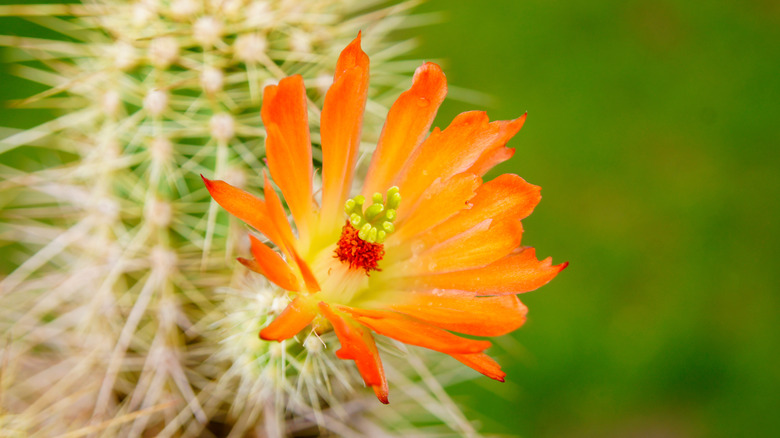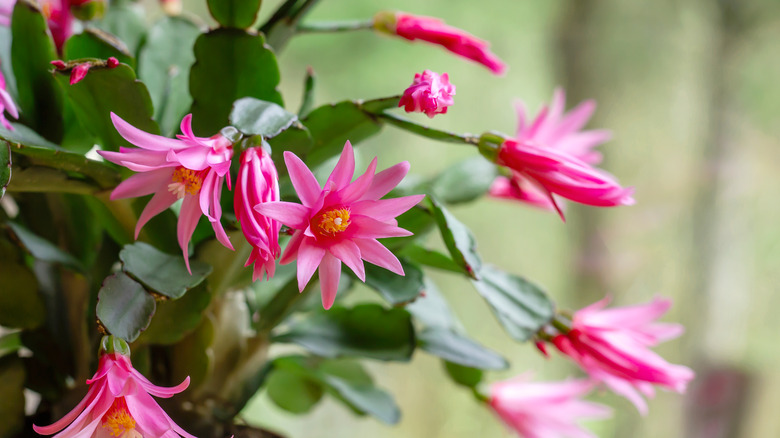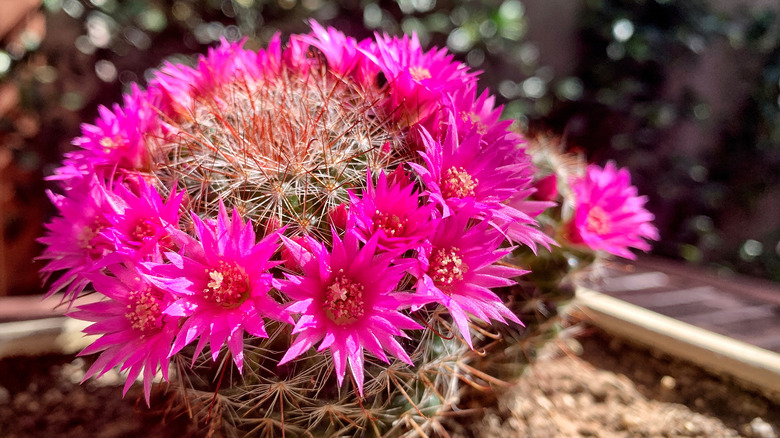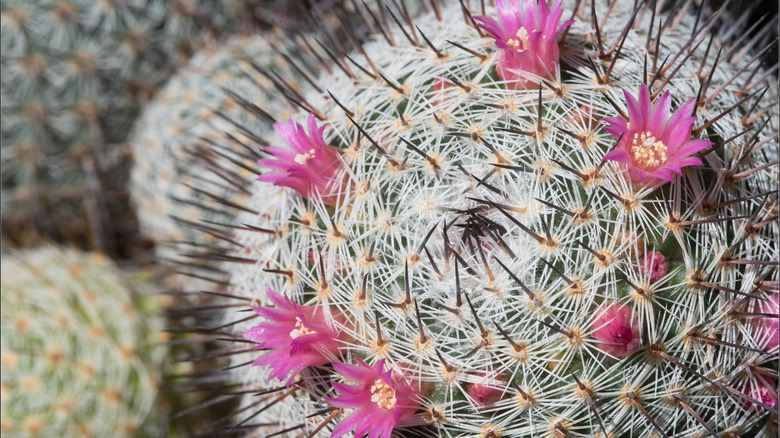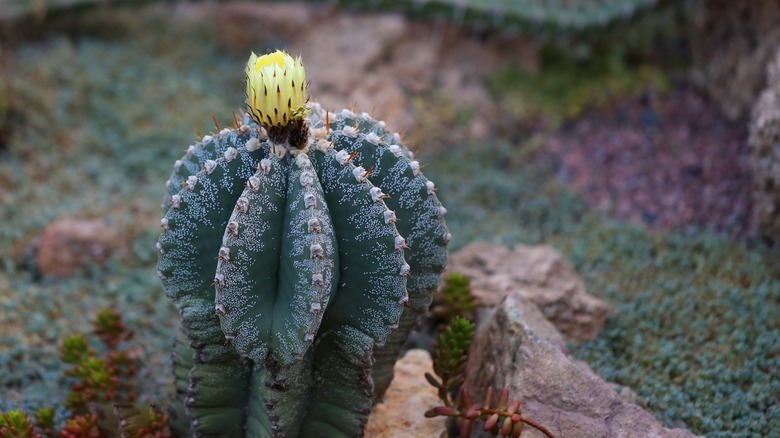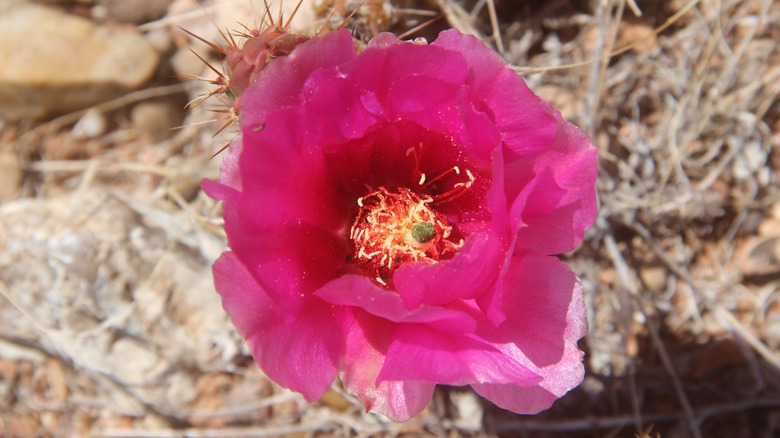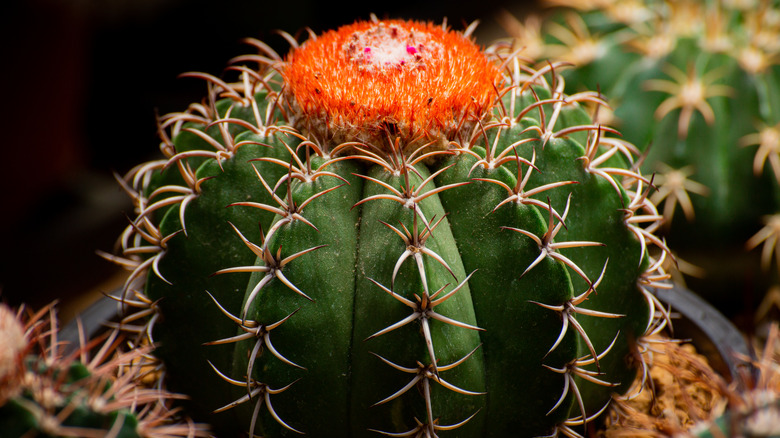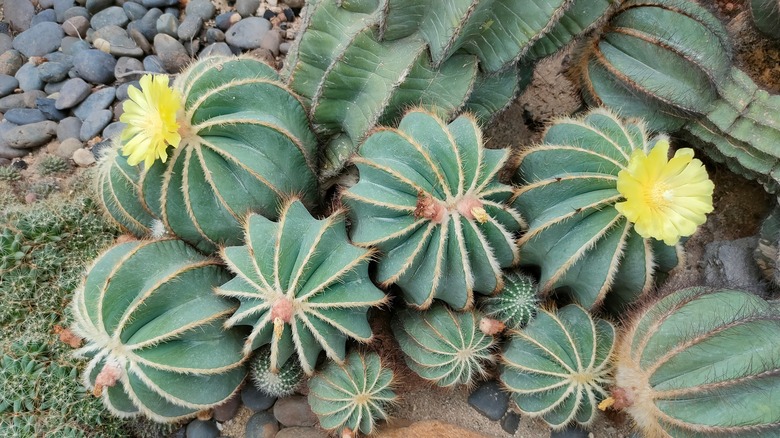15 Cacti You Should Grow That Bloom With Colorful Flowers
Flowering plants will always brighten a garden or enhance your indoor space, yet many flowers require lots of attention, water, and time-consuming care. For the gardener that can't keep up with high-maintenance plants, we recommend flowering cacti. Cactus plants are known to be drought-tolerant and neglect-tolerant. Most of them can be planted and then forgotten about for weeks at a time.
Keep in mind that most cacti require warm weather year-round, which means many of them can only be grown in USDA zones such as 8, 9, 10, and 11. However, there are a few exceptions, as told by High Country Gardens. These include cacti such as the prickly pear cactus (Opuntia aurea) and the claret cup cactus (Echinocereus triglochidiatus). Both of these cold-hardy species can live in climates as cold as USDA zone 5. Other flowering cacti will need to be grown indoors if you live in northern states that receive cooler weather. Likely, you'll find that growing cacti indoors can be just as rewarding when you notice their gorgeous blossoms in the spring and summer.
1. Christmas Cactus
Christmas cacti (Schlumbergera russelliana) are epiphytic flowering plants that are known for their showy, tubular flowers that may appear pink, red, white, purple, or yellow, as told by North Carolina State Extension. The cactus, which is also called the Thanksgiving cactus, is named for its bloom season, which may begin in the early fall to the end of winter.
Bloom Season: Fall and winter
USDA Growing Zone: 9 to 11
Growing Conditions: Full sun
Soil Type: Moist and well-draining
Size: 6 inches to 1 foot tall
2. Sulcorebutia Cactus
The sulcorebutia cactus (Sulcorebutia albissima) is also called the crown cactus. It features many spines that wrap themselves around the green flesh of the plant. According to RHS, in the summer, this cactus produces large purple-pink or yellow flowers. Often, these flowers form a halo or a crown around the top of the plant, which gives it its common name.
Bloom Season: Summer
USDA Growing Zone: 9 to 11
Growing Conditions: Full sun
Soil Type: Well-drained loam or sand
Size: 4 inches tall
3. Lady Fingers Cactus
The lady fingers cactus (Mammillaria elongata) can be identified by its many finger-like stems that form a wide mound. Throughout the spring and summer, pink to yellow flowers appear on the tips of the stems. Depending on the USDA zone that you live in, these cacti make great indoor or outdoor plants in containers, as per Gardenia.
Bloom Season: Spring to summer
USDA Growing Zone: 9 to 11
Growing Conditions: Full sun
Soil Type: Well-drained loam or sand
Size: 4 to 6 inches tall and 10 inches to 1 foot wide
4. Bishop's Hat Cactus
The bishop's hat cactus (Astrophytum myriostigma) is a star-shaped cactus that produces both flowers and fruit. This fruit is well-known in some cultures to produce hallucinations when consumed, as described by The University of Arizona. This plant is sometimes known as false peyote for its medicinal properties.
Bloom Season: Summer
USDA Growing Zone: 7 to 11
Growing Conditions: Full sun to light shade
Soil Type: Well-drained sand and chalk
Size: Less than 5 feet tall
5. Schlosser Cactus
The schlosser cactus (Parodia erubescens) is a small and round cactus species that is known for being easy to grow. People all over the United States enjoy growing these plants indoors or outdoors where they produce 2-inch-wide yellow flowers at their peak, explains Mountain Crest Gardens.
Bloom Season: Late spring
USDA Growing Zone: 10 to 11
Growing Conditions: Full sun
Soil Type: Well-drained cactus and succulent soil
Size: 6 to 8 inches tall
6. Old Lady Cactus
The old lady cactus (Mammillaria hahniana), or the old lady pincushion cactus, is another small, round cactus species that is very easy to grow. This plant requires very little care to survive and it is tolerant of neglect as well as drought, says Gardenia. If you are looking for an easy-to-care-for flowering cactus, the old lady is for you.
Bloom Season: Summer
USDA Growing Zone: 9 to 11
Growing Conditions: Full sun
Soil Type: Well-drained loam or sand
Size: 1 foot tall and 8 inches wide
7. Zulu Giant
The zulu giant (Stapelia gigantea) is well-known for its large 10- to 16-inch flowers that claim the title of one of the largest flowers in the world, as pointed out by Missouri Botanical Garden. This massive flower, though beautiful, does emit a putrid smell that is likened to rotting meat. Because of this, it is recommended to grow the plant outside where it has access to full sun and little water.
Bloom Season: Fall
USDA Growing Zone: 9 to 10
Growing Conditions: Full sun
Soil Type: Fertile and well-drained
Size: 1 foot tall and 2 feet wide
8. Claret Cup Cactus
The claret cup cactus (Echinocereus triglochidiatus) can reach heights of at least 2 feet tall, which isn't always common with flowering cacti. As shown on High Country Gardens, you'll find wide, cup-shaped flowers that form clusters at the top of each stem. The red flowers attract pollinators like hummingbirds, which can be great for your blooming outdoor garden.
Bloom Season: Late spring
USDA Growing Zone: 5 to 9
Growing Conditions: Full sun
Soil Type: Well-drained
Size: 2 feet tall and 2 feet wide
9. Easter Cactus
The Easter cactus (Hatiora rosea) looks very similar to the Christmas cactus even though they do not share the same species or genus. What sets this cactus apart from other holiday cacti is that it blooms in the spring around Easter. It produces pink tubular flowers that look their best when they are placed in full sun, via RHS.
Bloom Season: Spring
USDA Growing Zone: 10 to 11
Growing Conditions: Full sun to partial shade
Soil Type: Well-drained loam or sand
Size: 4 inches to 20 inches
10. Rosy Pincushion Cactus
The rosy pincushion cactus (Mammillaria zeilmanniana) is another Mammillaria species that forms a halo of small flowers on its stem. These flowers may be white, pink, or red, and they are known to bloom prolifically, as said by Mountain Crest Gardens. Unlike some other Mammillaria, this cactus is a slow-grower that will not grow much larger than 3 inches tall.
Bloom Season: Spring and summer
USDA Growing Zone: 10 to 11
Growing Conditions: Full sun
Soil Type: Well-draining cactus and succulent soil
Size: 3 inches
11. Twin-Spine Cactus
Twin-spine cacti (Mammillaria geminispina) are round plants that may grow in clusters to form a 3-foot-wide mat that is just under 10 inches tall, as explained by The University of Arizona. These plants show off a ring of pink-red flowers at the top of their stems that give way to small, red fruit that is edible.
Bloom Season: Spring
USDA Growing Zone: 10 to 11
Growing Conditions: Full sun
Soil Type: Well-drained
Size: 3 to 7 inches tall
12. Monk's Hood Cactus
The monk's hood cactus (Astrophytum ornatum) is also commonly referred to as the star cactus. As told by Mountain Crest Gardens, this tall growing cactus is easily identified by its spiraling ribs and its yellow flowers, which open in the summer. Though this plant is quite tolerant of neglect, you should keep it in full sun and provide it with water as needed.
Bloom Season: Summer
USDA Growing Zone: 10 to 11
Growing Conditions: Full sun
Soil Type: Well-drained cactus and succulent potting soil
Size: Up to 6 feet tall
13. Prickly Pear Cactus
The prickly pear (Opuntia aurea 'Coombe's Winter Glow') is a cold hardy cactus that is often grown in the United States. This specific variety is known for its mostly spineless green pads, pink flowers, and sprawling branches, as described by Missouri Botanical Garden. Other varieties of this species can have yellow flowers and many more spines on their blue-green pads.
Bloom Season: Spring and summer
USDA Growing Zone: 5 to 9
Growing Conditions: Full sun
Soil Type: Well-drained and sandy
Size: Up to 2 feet tall and 4 feet wide
14. Dwarf Turk's Cap Cactus
The dwarf Turk's cap cactus (Melocactus matanzanus) is a relatively low-maintenance plant, though it is known to be troublesome, as said by Planet Desert. The popular cactus is regarded for its round shape and its pink flowers that appear in the summertime. Keep in mind that this is not like other cacti. It requires quite a bit of water and humidity to survive.
Bloom Season: Summer
USDA Growing Zone: 10 to 11
Growing Conditions: Full sun
Soil Type: Well-drained
Size: Up to 4 inches tall
15. Balloon Cactus
The balloon cactus (Parodia magnifica), which gets its name from its round shape, is an ornamental species of cacti that grow in large clusters. From the tip of each stem, one or more yellow flowers bloom during the summer and fall, according to Gardenia. Their fun shape and gorgeous flowers make them a great addition to any cactus collection.
Bloom Season: Summer to fall
USDA Growing Zone: 9 to 11
Growing Conditions: Full sun
Soil Type: Well-drained chalk, sand, or loam
Size: 10 inches to 1 foot tall
